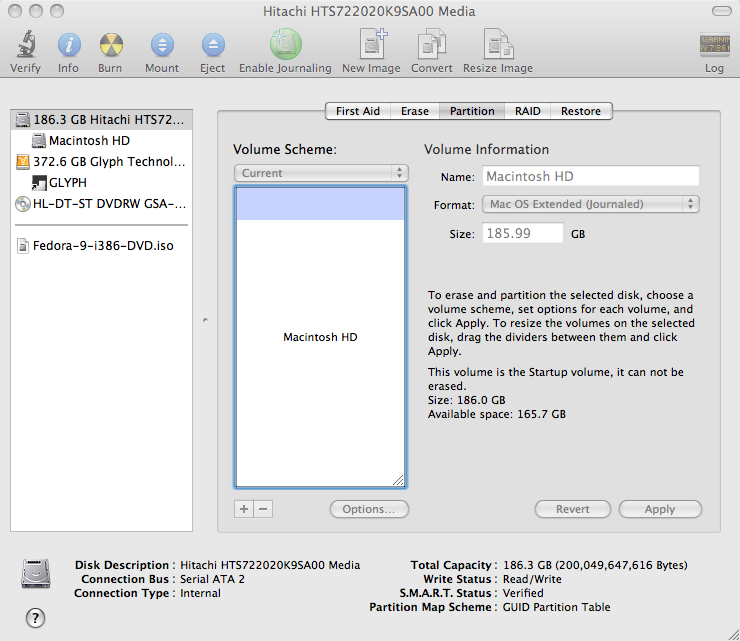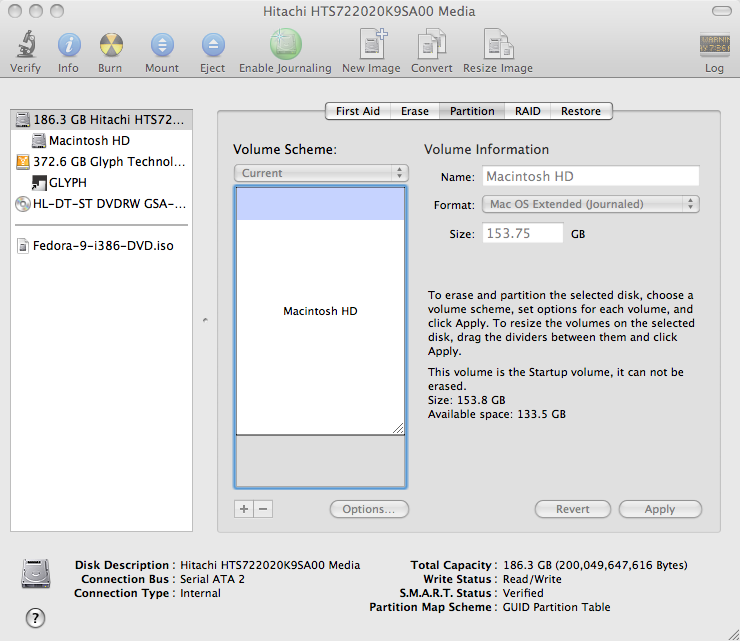MacTel PlanetCCRMA
Installation instructions for a MacBook Pro
Main steps:
1) Backup your data.
2) Partition your OS X drive.
3) Install boot loader.
4) Install (& update) Linux, first adding boot, Linux, and swap partitions.
5) PlanetCCRMA-lize your Linux.
Contents
Acquiring Fedora Media
You can borrow Install DVD's from SysAdmin anytime. You can also download your own to your Mac, by visiting Fedora. Make sure to download the i386 version, not the x86_64 even though your Mac is 64bit. Many programs have yet to be ported to 64bit.
You can save a bunch of time and consternation by checking the media integrity right away. Use the following command line to determine the SHA1SUM checksum (takes a few minutes).
openssl dgst -sha1 Fedora-9-i386-DVD.iso
Compare this output string to the one provided by Fedora [1]. Ignore the verify instructions on that page, they are for Linux, but you can find the checksums here: 'Install DVD/Rescue CD > i386' The checksums strings should match exactly. If not, you've got a corrupt download, and you'll have to try again. This doesn't happen often, but it's worth the extra few minutes.
Burn your downloaded image (the '.iso' file) to DVD with Disk Utility: Images > Burn ... Disk Utility can be found here: /Applications/Utilities/Disk Utility
Prep the Mac (resizing and the bootloader)
1. Update firmware (run software update or download latest OS from Apple)
2. Plug into power source; connect to internet via Ethernet.
2. Start OS X Disk Utility (Utilities menu): select top hard drive icon, click "Partition" tab.
Here's what it looks like before you do anyting.
You can now reduce the size of your Mac HD partition by selecting the target size of your new smaller partition. I chose a size of 50GB for PlanetCCRMA. You'll need at least 15GB for all PlanetCCRMA packages, plus some extra for your home directories. The choice is up to you. You have two options: Enter the target size (total HD size - 30GB, for me) directly in the field: 'Volume Information > Size' or under 'Volume Scheme' drag the botton right corner of the box up until your desired size shows in: 'Volume Information > Size'. Click "Apply", wait (can take some time).
You can see here the space for your new installation at the bottom of the 'Volume Scheme.' This is where Linux will go.
3. Install rEFIt. rEFIt install instructions [2]. It's a pretty straight forward Mac install.
Reboot to check rEFIt install (might take 2 reboots, we've found). A nice looking rEFIt screen shows before OSX boot but after the Apple chime.
This next part takes about 30 minutes.
Install Fedora from DVD
1. Make sure your Fedora disk is in the drive bay.
2. Reboot.
3. rEFIt will present you with a screen where you can select (with the arrow keys) the 'Linux penguin ('Tux') with the DVD' (rather than the apple) to boot from the Fedora install DVD. The machine will boot from the DVD and you'll be presented with a Fedora Install screen.
4. Unfortunately, how to take screenshots during install on the Mac has eluded us, so we'll have to stick with text descriptions (this is too bad).
- at the first screen choose: Install or upgrade an existing system, then press return/enter. The Mac will boot into the Fedora Installer.
- Media Check: skip it if you are comfortable you have a good disk (say it's been used successfully before), or check the disk media by selecting OK then Test (takes about 10 minutes). Select OK. The disk ejects. Just reinsert it. Give it time to spin up before you do anything (say 1 minute). Select Continue.
Fedora 9
- the X server starts and we enter the installation screen in earnest. Click Next at the first screen.
- choose your language, Next
- choose your keyboard layout, Next
- 'Network Devices:' select 'Set the hostname: automatically via DHCP. Unless you know that you need to change something else here, just click Next.
- set your Time-Zone, Next
- enter a root password, Next
(Note: you may start to see an annoying increase track-pad sensitivity. hope they'll fix this soon.)
Linux Partitioning
This description assumes you are only dual booting Mac OS X
"Your boot partition ought to be a primary partition, not a logical partition. This will ease recovery in case of disaster, but it is not technically necessary." [3]. So, we don't really need a boot partition.
You'll need to make a minimum of 2 partitions, but a t
First dropdown menu: Create custom layout; click "Next". New window: click on free partition box; click "New".
Swap partition: swap filesystem, select fixed size (RAM size x 2); click "OK".
Click "Next", accept defaults for next few sections.
Finish Fedora Install & Update, PlanetCCRMA-lization
6. Finish Fedora installation -- click "Next" to install Fedora.
7. Reboot computer, choose Linux Penguin icon from rEFIt menu, boot into Linux, follow instructions to do system setup.
8. Update Fedora: while plugged into Ethernet internet, in a terminal as root (su) type:
~> yum upgrade
This can take two hours or more, depending on size & download speed.
8. PlanetCCRMA Fedora 8 installation
9. Soundcard detection via: System>Administration>Soundcard Detection.
References
rEFit boot loader What is EFI [4]? Installation instructions [5]
Fedora8 on MacBook Pro (Santa Rosa 3,1)

